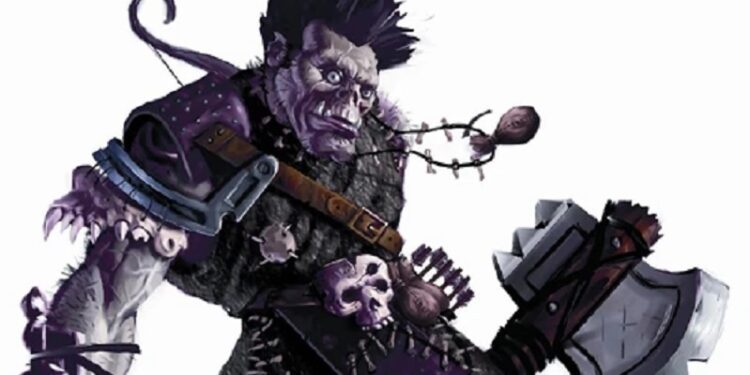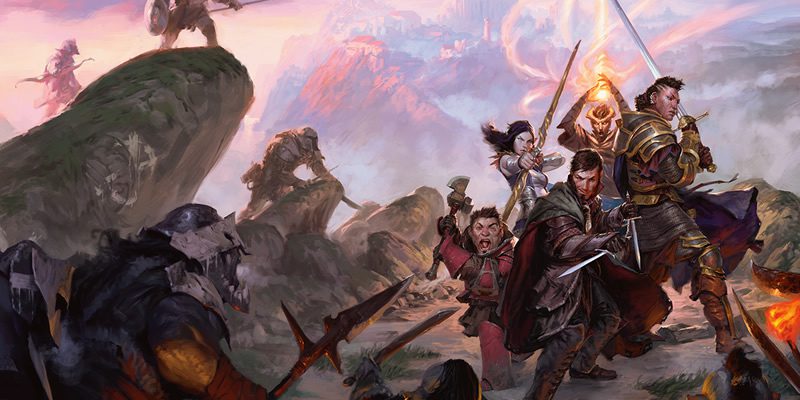The Barbarian Class, Part Three

Welcome back to the History of the Barbarian, this time getting into the barbarian of D&D 3.0 and 3.5. Why did they drop the A? Because they finally admitted that the Accidental Death & Dismemberment wasn’t so Accidental – especially for the Improbably Large Axe class! Do you like d12s? I hope you like d12s, because this class is very much about that die size, in particular.
Part One | Part Two | Part Three
After writing Part Two, Friend of the Blog Jared Rascher reminded me that 2e’s HR1: Vikings Campaign Sourcebook has a Berserker class that actually is the bridge between 2e and 3.0 barbarians. I’m covering that first, because in this series I’m terrible at being done with an edition, apparently!
HR1: Vikings Campaign – Berserker
There’s a pretty good amount of flavor and historical-background text to go with this class. My inner lit nerd who studied the Prose Edda for a class in college appreciates the paragraph on the Icelandic sagas!
- Requires Str 14+, Con 14+, and Cha 13+. They don’t really explain a rationale for the Cha requirement. They can be humans or trollborn (a race found in this book).
- d10 HD.
- Uses the paladin/ranger XP table. +10% XP if Str and Con are both 16+.
- Can become proficient with all weapons, can wear any armor, and gains attacks per round as a paladin or ranger. (Since they’re Warriors, we know that they have the 1/level THAC0 progression.)
- Must be Chaotic in alignment.
- You get 2 fewer starting weapon proficiencies, and you can’t ever become proficient with weapons that are ranged-only such as bows or slings. Melee weapons that you can reasonably throw, such as spears, are fine.
- Going berserk is – of course – their core feature, and it does a lot at once.
- Spend a round to enter the berserk state, and it requires a save vs. death magic. On a success, you go berserk; otherwise you can keep trying for up to 10 rounds, succeeding automatically in the 10th
- +2 Str, to a maximum of 19, though for Str 18(xx) categories, that’s +2 brackets.
- +2 hit points per level; these are lost first in the manner of temporary hit points in 3.x and later, and loss of these hit points doesn’t carry over when you leave the berserk state.
- -1 AC (improvement) per level, to a maximum of AC 0, as long as you aren’t wearing armor. Dex, magic items, spells, and shields still apply.
- +2 to saves against charm and mental attacks.
- You can’t hang back in the fight, and you can’t move on from one enemy to another until the first is slain or flees and can’t be pursued. Your berserk state ends immediately if you withdraw or retreat from combat.
- You can only go berserk for a number of rounds (minutes, remember) equal to your Constitution score. When your berserk state ends (voluntarily or not), you save vs. death again; on a failure you’re exhausted, taking 5 points of temporary Strength damage. You recover 1 pt per turn (10 minutes) of rest, and can’t go berserk again until that’s all recovered. This is a surprisingly on-the-nose “once you use this feature, you can’t do so again until you finish a short rest” phrasing.
- At 4th level, once per week (!), you can shapechange into a wolf. Given the movement speed, this is maybe more of a “travel form” than something you’d do on purpose in standard combat.
- At 7th level, once per week, you can shapechange into a cave bear. This is a much more reasonable combat form, especially as a way to get 3 attacks per round (d6 claw/d6 claw/d8 bite) in the early-mid game. Further, if you hit with a claw on a natural 18, 19, or 20, you bear hug for an extra 2d12 damage! You don’t see features like that in PC hands very often in 2e.
- You gain followers at 9th level, as usual for a warrior, but only a small number of fanatically-loyal heroes, not an army.
- At 12th level, you can spirit-journey once per day, entering a trance and venturing beyond your own body in the form of an animal spirit (bear, bull, falcon, huge raven, wolf). You can fight in this form and retain many of your own stats (hit points, saves, THAC0, unarmored AC). This is even more exhausting than berserking – you take a -4 to your save, and if you fail, your Str and Wis are halved, recovering at 1 pt per hour (first Strength, then Wisdom).
- The implementation is a bit idiosyncratic, but I love the idea of this – I think it would be really cool to have a location that is “haunted” by an animal spirit, only to reveal that a berserker has been imprisoned deep inside.
- You can gain an XP bonus by demonstrating bravery in leading the charge into battle against a superior force. This is in keeping with 2e’s class-specific small XP boosts. A non-scaling 200 XP is great early on, but fades into dubious relevance by around 5th I would argue that that’s a common problem across all of 2e’s class-specific rewards, though.
The shapeshifting thing mostly doesn’t carry forward, though the thematic connection to 5e’s Totem Warrior barbarian is interesting. The berserking mechanic – other than the continuing difficulty of initiating the berserk state – reads like an odd mashup of 3.x and 5e barbarian rages. On one side, you have the Strength, hit point bonuses, and bonus to saves against charm and mental attacks; on the other, unarmored defense. As long as you sometimes have enough forewarning to start going berserk before a fight (so that you’re not always missing 1 or more rounds of battle to doing nothing), this looks like a solid addition to the 2e class roster to me.
D&D 3.0
This is the first appearance of the barbarian as a core, Player’s-Handbook class, with Krusk the half-orc as the iconic barbarian. He has some weird posture problems, but in the main I like Krusk. Barbarians were middling-popular in our 3.0 games; they face the problem of competing with fighters for party role, in the edition where fighters get to play the feat game wildly more than everyone else.
-
- d12 Hit Die.
- Must be non-lawful, and you lose access to your Rage feature if you ever become I deeply dislike this implementation of alignment rules.
- Your class skill list is a stripped-down version of the ranger skill list. You gain 4 + Int modifier skill points per level… and let’s be real, no one has a great Int score to spare for their barbarian, so this nice long skill list is of questionable usefulness.
- Unlike every other class in the game, you have to pay 2 skill points to be able to read and write languages that you speak.
- Proficiency with simple and martial weapons, light and medium armor, and shields.
- Good progression in Fortitude saves, bad progression in Reflex and Will saves.
- +1/level Base Attack Bonus, of course.
- Rage is your core feature, of course. You start with 1/day and build up to 6/day at 20th. Rage gives you:
- +4 Str, +4 Con, +2 to Will saves, -2 AC. The Con boost increases your hit points, but you lose those hit points when you stop raging; as a result, starting at 5th level, your rage ending while you’re at 0 hit points is instant death. At higher levels, you die if your rage ends while you’re at some low but positive number of hit points. (Suffice it to say that this is kind of cool once, as your rage delays your inevitable death, but kind of awful as a baseline function. Try to stay near the cleric, I guess.)
- At the end of the rage you’re fatigued (-2 Str, -2 Dex, can’t charge or run) until the end of the current encounter. You can’t rage again in the same encounter.
- Entering a rage is a free action that you can only take on your turn.
- You can’t cast spells or use skills that require focus, and you can’t use the Expertise feat to increase your AC.
- At 15th level, your stat boosts increase to +6 Str, +6 Con, and +3 to Will saves.
- While you’re wearing light or medium armor and not heavily encumbered, you gain +10 speed.
- Uncanny Dodge starts at 2nd level, and grants additional features at 5th and 10th levels.
- At 2nd, you still gain your Dex bonus to AC while you’re flat-footed or attacked by an invisible creature.
- At 5th, you can’t be flanked except by a rogue with 4 more levels of rogue than you have of barbarian. This points to the Back Attack feature that 1e and 2e barbarians got – just without a retributive attack in this case.
- At 10th, you gain a +1 bonus to Reflex saves and AC against traps, scaling to +4 at 19th level. This is particularly unhelpful, as the DMG encourages DMs to phase out the use of traps above 10th level (by having trap CRs stop at 10).
- At 11th level you gain Damage Reduction 1/–, shaving 1 point of damage off every individual source of damage you take; this scales to 4/– at 20th level.
The features combine to make you a high-damage, high-hit point killing machine that is still pretty easy to hit and pretty likely to just be dead at the end of their rage. Still, the additional attack and damage bonuses of +4 or +6 Strength are substantial, especially as you make more attacks in a round. On the other hand, recalculating your character sheet as your Strength, Dex, Con, AC, and Will save bonus move all over the place is a headache and a half.
Lastly – notice the “dead” levels: 3, 6, 7, 9, and 18. Four of those are levels you otherwise gain a feat (assuming you’re not multiclassing), and 6th also grants you an iterative attack. That’s still a design element that’s going to change in the revision.
As a side note, the sohei class of 3.0’s Oriental Adventures blends the barbarian’s Rage mechanic with the monk’s Flurry of Blows mechanic to create Ki Frenzy – bonuses to Str, Dex, and speed, as well as an optional additional attack (but all of your attacks for the round are -2 to hit). I mention this only because I had a great time as a sohei from 1st to about 10th level in a campaign I played in college.
D&D 3.5
The Background section here that discusses barbarians coming from uncivilized lands or the outskirts of civilization just reminds me of a friend of mine who played a barbarian in an Eberron game, leaning into being an Action Hero rather than in any sense uncivilized. I appreciated how that move fit the setting’s pulpy tone.
I’m only covering the changes here:
- Your bonuses from rage improve to +6 Str/+6 Con/+3 Will at 11th rather than 15th, and you now gain Mighty Rage at 20th level that increases the bonus to +8/+8/+4.
- The trap avoidance function now starts at 3rd level, scaling up to +6 Ref save and AC against traps at 18th An additional point of Trap Sense is often the only new thing you get at a level, so getting rid of dead levels is often more about aesthetics than actually getting something meaningful.
- Damage reduction starts at 7th level rather than 11th, and scales up to 5/– at 19th level. 1 point of DR doesn’t mean a ton more that 7th than it does at 11th, but does help you feel a little better about the whole deal.
- Indomitable Will at 14th level gives you an additional +4 to Will saves against enchantment spells, on top of your existing bonus, while raging. I appreciate any effort to make the often-low-Wis barbarian less of a mental puppet and party liability.
- Tireless Rage at 17th level lets you off the hook of being fatigued at the end of your rage.
It’s a boost across the board, and becomes more noticeable as you move into the midgame. Barbarians are a giant bag of hit points, relatively easy to hit but kicking out tons of damage. I’m absolutely not getting into all of the feats and prestige classes of 3.5e that were targeted at barbarians – we’d be here all week – so I’m only commenting a bit on those found in Complete Warrior.
The Bear Warrior draws on the animal shapeshifting themes we see in HR1: Vikings Campaign. You transform into a bear (first black, then brown, then dire) and get incredible boosts to your ability scores as a result. “While in dire bear form, he gains a +20 bonus to Strength, a +2 bonus to Dexterity, and a +8 bonus to Constitution.” Yowza.
The Eye of Gruumsh is only for orcs and half-orcs who are devoted to Gruumsh and willing to put out their right eyes. The prestige class emphasizes blindness and perception, ritual scarification for natural armor bonuses to AC, blinding one’s enemies, and commanding other orcs and half-orcs in the area. It’s a concept that isn’t great for PCs (because of alignment restrictions and not having a horde of orcs to command), but it’s very powerful if it does suit you.
The Frenzied Berserker is for barbarians who are comfortable with turning on their teammates… regardless of what their teammates may think about the matter. They gain a special Frenzied Rage that gives them even more Strength bonus (+6) and an extra attack per round at their highest base attack bonus. Just a few caveats: they take nonlethal damage each round, they have an even worse AC penalty, and they have to succeed a DC 20 Will save to end the rage early. If you’re out of obvious enemies and still raging, you must keep attacking the nearest creature. You even gain extra features to make absolutely sure that your party has to fully kill you to stop you! (In short, I loathe this prestige class and the PvP that comes out of it.)
The Rage Mage lets barbarian/spellcaster multiclass builds cast spells even while raging, eventually gaining the ability to quicken spells (so they can cast more than once per round), wear armor, and cast spells even while under Tenser’s transformation.
There are a few others that are equally targeted at barbarians and other warrior-types, but I’m not sure they call for individual coverage. I’m not sure we’ll see too much that relates to later iterations of the barbarian, in any case.
That’s about it for my coverage of barbarians in D&D 3.x. Rage is now their central gameplay feature, and any tweak or iteration on the barbarian needs to relate to their rage in some way. As we’ll see in future articles, 4e and 5e also emphasize rage in one way or another. As much as possible, you don’t want to be in a fight and not raging from here on out. That’s a massive shift in the conception of the class compared to the non-spellcasting wilderness warrior of Unearthed Arcana.



